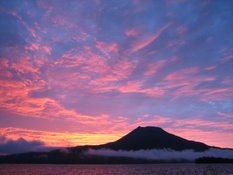 Starting around the 700 CE, Japanese emperors basically said, "I'm tired of all this moving around! Let's just pick a new spot and stay there!" So they did. For at least 100 years. Then they moved to Kyoto. For almost a thousand years.
Starting around the 700 CE, Japanese emperors basically said, "I'm tired of all this moving around! Let's just pick a new spot and stay there!" So they did. For at least 100 years. Then they moved to Kyoto. For almost a thousand years.What really made the day for Chuck and I was the volunteer tour guide who led us around the city. She was a university student who wanted an opportunity to speak English with native speakers.
Being a tour guide is a great way to do that: you rehearse some set phrases for each city landmark and you also speak spontaneously about predictable and unpredictable topics in English. As a language teacher, I can see how it reinforces old vocabulary, introduces new vocabulary and accents, and broadens one's knowledge about their own and their guests' cultures.
I came to Nara last November and saw the same sites. Without a guide, they're just impressive structures. With a guide, they come alive and grow richer with the historical and anecdotal context. It is a luxury to have instant access to a cultural informant who can explain everyday things that baffle the visitor to Japan. I don't get this opportunity often, so you can imagine how many questions I had for our guide!
We ended up strolling around Nara for about 4 hours. June is the rainiest month in Japan. My Japanese co-workers and expat neighbors would have me believe that it rains for the entire month and nothing ever gets dry. So when we've had sunny days, I've been confused. The truth is, it is statistically the wettest month, it doesn't mean that someone turns the "rain" switch on June 1st and off June 30th. So on this day, Chuck and I escaped most of the rain. We had a strong downpour when we were inside the largest wooden building in the world: Todaiji Temple (2/3 of its original size. Tall wood things don't last long without lightning rods!).
Chuck was fascinated with all the deer roaming freely through the center of town.
 According to Shinto beliefs, they are spiritual messengers and therefore cannot be hunted. Apparently one of them had a message for Chuck. He was really surprised to hear it! Many vendors sell deer biscuits to feed them. The deer catch on to this and smell you up to see if your "packing" any. Could that be the message they are trying to send? We may never know.
According to Shinto beliefs, they are spiritual messengers and therefore cannot be hunted. Apparently one of them had a message for Chuck. He was really surprised to hear it! Many vendors sell deer biscuits to feed them. The deer catch on to this and smell you up to see if your "packing" any. Could that be the message they are trying to send? We may never know.On our way back from Nara, we stopped in a little restaurant for some tasty Okonomiyaki. I call it a "savory pancake" because it looks like a pancake but consists of egg-flour batter with seafood and/or vegetables mixed with strong sauces.
 This picture is of Hiroshima-style Okonomiyaki, with the ingredients layered on. Kansai-style has the ingredients mixed together. Obviously Kansai-style is better;) Chuck wanted "see-food" that night, reminiscent of the popular Benihana's restaurants in the USA where the chef does a lot of fanfare with the food preparation to entertain the guests sitting around the table. I haven't seen one of those here. They probably exist, but I just haven't had the large group of people to go with or the money burning a hole in my pocket to patronize the establishment. So at this restaurant, the cooks prepare the food in front of you, but you have to slip them a 10,000 yen note to get any hoopla out of them! Anyway, we crammed into the tiny restaurant and waited a good 20 minutes, but it was worth it. Chuck gobbled his dish up before me, and with chopsticks at that!
This picture is of Hiroshima-style Okonomiyaki, with the ingredients layered on. Kansai-style has the ingredients mixed together. Obviously Kansai-style is better;) Chuck wanted "see-food" that night, reminiscent of the popular Benihana's restaurants in the USA where the chef does a lot of fanfare with the food preparation to entertain the guests sitting around the table. I haven't seen one of those here. They probably exist, but I just haven't had the large group of people to go with or the money burning a hole in my pocket to patronize the establishment. So at this restaurant, the cooks prepare the food in front of you, but you have to slip them a 10,000 yen note to get any hoopla out of them! Anyway, we crammed into the tiny restaurant and waited a good 20 minutes, but it was worth it. Chuck gobbled his dish up before me, and with chopsticks at that!Nara was the first of 3 straight day trips to the cultural treasures of Kansai. Next entry: Eastern Temples of Kyoto!





No comments:
Post a Comment